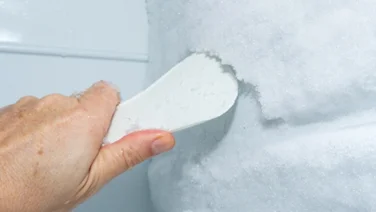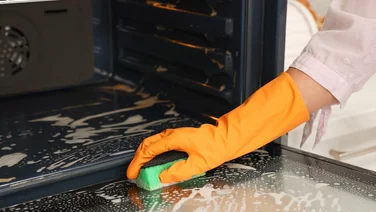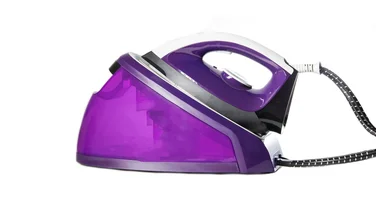To help us provide you with free impartial advice, we may earn a commission if you buy through links on our site. Learn more
- How to measure out washing powder or liquid detergent
- Things to try instead of adding more detergent
- What happens if I use too much laundry detergent?
- Washing machine features that help with detergent dosing
- Using your detergent drawer properly
- Can you use a washing machine without detergent?
- How detergents work

Along with heat, motion and water, detergent is one of the four basic elements used by washing machines to clean clothes, bedding and other laundry items.
We’re all accustomed to tweaking the spin speed or the temperature of a wash to specific requirements – but it’s rare that the majority will pay the same level of attention to precisely measuring out the amount of detergent to add.
Guesstimating how much detergent to use can become a problem, with the result that items could come out of the machine unclean, stiff or sodden with soap bubbles. We’ve put together this guide to help you use just the right amount, every time you wash.
| Common laundry detergents – and how much to use with a medium wash load (4-5kg) | |||
| Type | Description | Examples | Guideline dose |
| Washing powder | A detergent in powder form, combining surfactants with other ingredients such as scents and whitening agents. | 100ml | |
| Liquid laundry detergent | A detergent in liquid form, in which surfactants and other active ingredients are diluted by water. | Two tablespoons (30ml) | |
| Laundry pods / capsules | Liquid detergent in a water-soluble pouch. | One pod | |
| Laundry sheets | A water-soluble rectangular strip of detergent. | One strip | |
There are four common forms of laundry detergent. From the most traditional to the newest, these are:
- Washing powder
- Liquid laundry detergent
- Laundry pods
- Laundry sheets
These detergent delivery methods all have their merits. Liquid detergents are great for quick washes, as they tend to dissolve quicker than powders or pods. Pods and sheets are user-friendly and impossible to over-use (unless you decadently add more than one at a time). And washing powder remains a familiar staple.
Choosing how much of a particular detergent to use is complicated by the fact that these products come in varying concentrations. Highly concentrated examples are usually more expensive (£/ml), and are touted for their eco credentials due to the fact that less fuel is required to transport the product from factory to warehouse, to retailer, to home.
If your detergent is highly concentrated, be sure to use a relatively low volume of it with each wash load.
READ NEXT: Best washing machines
How to measure out washing powder or liquid detergent
Back in the heyday of corporate recklessness, washing powder was often supplied with a measuring scoop in every box. However, these implements have been widely phased out, as brands seek to reduce their use of plastics. Fortunately, the planet’s gain isn’t really your loss, since the design of the scoops often led users to dole out too much powder.If you don’t already have a measuring scoop, you can purchase one for repeat use, such as this 100ml scoop, for not much money. Alternatively, you can use a tablespoon (approximate capacity: 15ml) to feed washing powder into a washing machine’s detergent drawer.
Meanwhile, if you’re using a liquid laundry detergent, then it’s best to use a “washball” to load the liquid into the drum. Like the scoops for washing powder, these too were often supplied with the detergents, but are now generally bought as a standalone accessory. To ensure you’re measuring out your detergent accurately, choose a washball with a measuring scale that indicates volume in millilitres.

Even when using a washball, pouring the correct amount of liquid out of the bottle can be difficult. “Many of us find measuring from big bottles of laundry detergent extremely tricky as a result of oversized bottle necks and large caps, so if you’re still using bottles of laundry liquid then it’s time to find a tablespoon,” says Catherine Green, a sustainable cleaning expert at the eco-friendly cleaning brand, smol.
“For a 7kg washing machine drum that’s doing a full load of laundry, you probably only need two tablespoons of standard liquid detergent to get that clothing clean,” says Green.
“Of course the amounts recommended by most liquid detergent manufacturers will vary, but all of them are going to suggest more than two tablespoons,” she adds. “At the end of the day, they want you to buy more of it.”
READ NEXT: Best laundry detergents
Things to try instead of adding more detergent
Slightly increase the wash temperature
When stains prove difficult to remove, you might be tempted to run a second wash but using more detergent. While this approach might bring success on occasion, the solution often lies elsewhere.
One alternative to try is to increase the wash temperature (within the limits outlined in the care instructions for your textile).
These days, most laundry detergents (especially “bio” ones) are formulated to work effectively at temperatures as low as 30℃, or even 20℃. However, since the reactions of detergents with dirt and water are often encouraged by heat, the hotter the wash temperature, the more effectively most detergents will remove stains and dirt from your laundry.
As you may have already guessed, though, the trade-off here is that hotter wash settings consume more energy, plus some fabrics are susceptible to shrinkage or colour transfer when they’re washed too hot. Never wash fabrics at a hotter setting than the one specified on the care label.
Treat stains before washing
Some stubborn stains can be removed only by using a special treatment. If you’ve tried to tackle a stain that’s proved stubborn to remove in a wash cycle, then you might see more success with a stain removal treatment such as Vanish PowerGel Stain Remover.
READ NEXT: How to clean your washing machine
What happens if I use too much laundry detergent?
Bubbles galore – and possibly more. The results of having used too much washing powder will be clear in the form of an overabundance of suds in the drum once a wash cycle has finished.
Excess detergent in your wash load can even physically change the feel of clothes – often for the worse. “Stiff, starchy, scratchy clothes are a common sign that you’re using too much detergent,” says smol’s Catherine Green. “The excess bubbles will start to trap detergent residue in your clothes because they cushion your clothing from rubbing up against each other during the cycle.”

According to Green, there can be negative consequences for your washing machine, too. “Too much detergent will cause more bubbles, preventing the machine from draining completely and will leave clothing still wet,” she says.
“A nasty smell can develop in your machine, from bacteria and mould that begins to grow on the leftover liquid or softener. These liquids often contain animal fat, which is perfect for this growth (although we’d like to note that smol detergent and softener do not contain animal fat).”
Note, too, that some people with sensitive skin (or who are sensitive to strong scents) may experience irritation due to the use of a harsh detergent. Such reactions may be worsened when the product is used in excessive quantities.
READ NEXT: Best Bosch washing machines
Washing machine features that help with detergent dosing
Several appliance brands now offer washing machines with an auto-dosing feature. These machines release an appropriate volume of detergent into the drum that takes account of factors such as the weight of the laundry load and the chosen wash programme.
Auto-dosing washing machines tend to be relatively expensive; but, over the years they might save you some money in overused detergent (and its knock-on effects, including damage to textiles and the washing machine).
Some popular examples include:
There are other features that help make better use of detergent, too. For example, the ActiveCare programme on some Hotpoint washers (such as the NM11946WCAUKN) pre-mixes water and detergent into a sort of mousse before it’s released and the wash cycle begins. The brand claims that this process contributes to effective stain removal at very low wash temperatures.
Similarly, Hisense appliances such as the 3 Series WDQA8014EVJMT washer-dryer have a “PureJet” feature that dissolves detergent into your laundry items.
Some appliance manufacturers offer proprietary detergent systems with their own detergent products made for use with specialised components within their washing machines. For example, some Miele washing machines – such as the W1 TwinDos WWG 660 WCS – come with a CapDos system, which can be used with the brand’s own detergent capsules.
READ NEXT: Best eco-friendly laundry detergents
Using your detergent drawer properly
It’s likely that the majority of people will be using their washing machine incorrectly – from choosing ill-suited cycles for the items they’re wanting to clean, to overloading the drum with too much laundry. We suspect no component of these appliances is the focus of more error and confusion than the detergent drawer.
If you’re using a washing powder (rather than a liquid detergent that can be loaded straight into the drum via a washball), then you’ll need to add it via this drawer. Many washing machines have a detergent drawer with two compartments: one for detergent (i.e. washing powder) and another for additional products, such as fabric softener. Adding washing powder to the correct compartment for your particular washing machine will see it work most effectively. Refer to your appliance’s instruction booklet to discover the correct one.

Even when loaded correctly, the detergent drawer is a common source of washing machine problems, due to the propensity for black mould to develop inside this component as some moulds feed on soap. Dry the drawer with a cloth or kitchen roll between uses, to limit the risk of mould forming in the first place.
READ NEXT: How to clean your washing machine drawers
Can you use a washing machine without detergent?
There’s no harm using a washing machine without any detergent at all – perhaps except for the fact your laundry probably won’t come out perfectly clean.
Machine-washing without detergent does some good for laundry, since the motion of the drum and the rinsing effect of the water may at least remove surface-level dirt. However, detergent is required to remove stubborn dirt, stains and strong odours.
While most washable items can be cleaned using detergent, some textiles may suffer from colour leakage when washed with this type of product. Stuffed toys, in particular, may become faded through the use of detergent.
“If you’re washing a stuffed toy for the first time, check it can withstand washing detergent without any colour fade,” advises Vivien Fodor, laundry category manager at Indesit. “You can do this by dabbing a small amount of diluted detergent on a part of the toy that is hidden (we recommend under the arm or even an ear).” If the toy (or other item) fails the spot test, you might have to find an alternative cleaning method.
READ NEXT: Best integrated washer-dryers
How detergents work
Detergents contain molecules called surfactants, also known as “surface active agents”. Simply put, surfactants have a “hydrophobic” tail that’s attracted to matter such as dirt and grease, and a “hydrophilic” head that’s attracted to water. When placed in water with dirty laundry, the surfactants in the detergent grab dirt molecules and pull them away from the fabric.
If, like us, you find this sort of thing interesting, you can find a more in-depth explanation via the University of York.
Almost all washing powders contain surfactants (as do washing-up liquids and many other cleaning products). However, there’s some variety in the types of surfactant used.
Many laundry detergents contain a synthetic surfactant called linear alkylbenzene sulfonate (LAS), which is derived from oil. For the eco-conscious, there are alternative options that use plant-derived surfactants instead, such as Eco-Max Non-Bio Laundry Liquid – Natural Orange.






